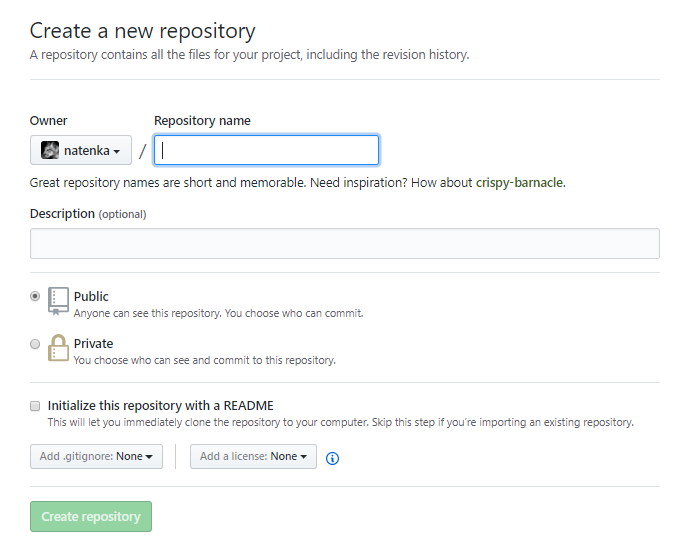Working with own repository#
This chapter covers how to work with repository on your local machine.
Creating a Github repository#
To create a Github repository you need:
log in to GitHub
In upper right corner press plus and select “New repository” to create a new repository
Name of repository should be entered in window that appears
You can put “Initialize this repository with a README”. This will create a README.md file that only contains repository name.

Cloning a Github repository#
To work locally with repository, it should be cloned.
Use git clone command to clone repository:
$ git clone ssh://git@github.com/pyneng/online-2-natasha-samoylenko.git
Cloning into 'online-2-natasha-samoylenko'...
remote: Counting objects: 241, done.
remote: Compressing objects: 100% (191/191), done.
remote: Total 241 (delta 43), reused 239 (delta 41), pack-reused 0
Receiving objects: 100% (241/241), 119.60 KiB | 0 bytes/s, done.
Resolving deltas: 100% (43/43), done.
Checking connectivity... done.
Compared to this command, you need to change:
pyneng user namefor your Github user nameonline-2-natasha-samoylenkorepository name for your Github repository
As a result, in current directory in which git clone was executed, a
directory with name of repository will appear, in my
case - “online-2-natasha-samoylenko”. This directory now contains the contents of Github repository.
Working with repository#
The previous command not only copied repository to use it locally, but also configured Git accordingly:
Folder .git was created
All repository data is downloaded
Downloaded all changes that were in repository
Github repository is configured as a remote for local repository
Now you have a complete local Git repository where you can work. Typically, sequence of steps will be as follows:
Before starting, synchronize local content with Github using
git pullcommandModifying repository files
Adding modified files to staging with “git add” command
Commit changes using
git commitcommandTransferring local changes to Github repository with
git pushcommand
When working with tasks at work and at home, it is necessary to pay special attention to first and last step:
The first step is to update local repository
The last step - load changes to Github
Synchronizing local repository with remote repository#
All commands are executed inside repository directory (in example above - online-2-natasha-samoylenko).
If contents of local repository are the same as those of remote repository, output will be:
$ git pull
Already up-to-date.
If there were changes, output would be something like this:
$ git pull
remote: Counting objects: 5, done.
remote: Compressing objects: 100% (1/1), done.
remote: Total 5 (delta 4), reused 5 (delta 4), pack-reused 0
Unpacking objects: 100% (5/5), done.
From ssh://github.com/pyneng/online-2-natasha-samoylenko
89c04b6..fc4c721 master -> origin/master
Updating 89c04b6..fc4c721
Fast-forward
exercises/03_data_structures/task_3_3.py | 2 ++
1 file changed, 2 insertions(+)
Adding new files or changes to existing files#
If you want to add a specific file (in this case, README.md), you need to enter
git add README.md command. All files of current directory are added by git add . command.
Commit#
You should specify message when you are running a commit. It is better if
message is with meaning, rather than just “update” or similar. Commit could
be done by a command similar to git commit -m "Tasks 4.1-4.3 are completed".
Push on GitHub#
Command “git push” is used to load all local changes to Github:
$ git push origin master
Counting objects: 5, done.
Compressing objects: 100% (5/5), done.
Writing objects: 100% (5/5), 426 bytes | 0 bytes/s, done.
Total 5 (delta 4), reused 0 (delta 0)
remote: Resolving deltas: 100% (4/4), completed with 4 local objects.
To ssh://git@github.com/pyneng/online-2-natasha-samoylenko.git
fc4c721..edcf417 master -> master
Before executing git push you can run git log -p/origin.. - it will show
what changes you are going to add to your repository on Github.